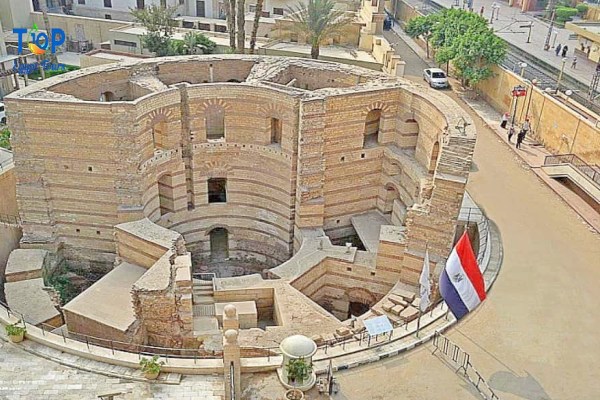Babylon Fortress, located in Cairo, Egypt, is a fascinating historical site that offers a glimpse into the city’s ancient past. Built during the Roman period, this fortress played a crucial role in the defense of Egypt and served as a significant administrative center. This article explores the captivating features, historical context, and cultural significance of the Roman Fortress of Babylon.
In this article, we will uncover for you the Babylon Fortress with Top Ten Egypt.
Babylon Fortress: A Testament to Military Architecture
The Roman Fortress of Babylon showcases remarkable military architecture and engineering. The fortress is a rectangular structure with a perimeter of over 1.5 kilometers. It is surrounded by a massive defensive wall, which is up to 10 meters thick in some places. The wall was punctuated by towers and bastions, which provided excellent vantage points for soldiers to survey the surrounding area and repel invaders.
The fortress also has four gates, which were heavily guarded and reinforced with iron doors. The main gate is located on the eastern side of the fortress and is flanked by two towers. It is decorated with intricate carvings, including a depiction of the Roman emperor Diocletian.
The fortress is constructed of limestone and brick, which have contributed to its longevity. The limestone was quarried from nearby Mokattam Hills, while the bricks were made from clay dug from the Nile River. The construction of the fortress was a massive undertaking, and it is estimated that it took over 10 years to complete.
Historical Context: The Roman Influence in Egypt
The Roman Fortress of Babylon was constructed during the Roman period when Egypt was under Roman rule. The Romans conquered Egypt in 30 BC, and they ruled the country for over 600 years. During this time, the Romans had a profound impact on Egyptian culture, governance, and architecture.
The Roman Fortress of Babylon was built during the reign of the Roman emperor Diocletian (284-305 AD). Diocletian was a skilled military strategist, and he recognized the strategic importance of Egypt. The fortress was built to protect the country from invaders and to serve as an administrative center for the Roman government.
The fortress also played an important role in the spread of Christianity in Egypt. The Coptic Christian community flourished under Roman rule, and the fortress became a center for Christian worship and learning.
Function and Importance: Safeguarding the Gateway to Egypt
The Roman Fortress of Babylon played a pivotal role in protecting the city and controlling access to Egypt. The fortress was located at the southern end of the Nile River, which was the main gateway to Egypt from the south. The fortress also guarded the important trade routes that passed through Egypt.
The fortress was garrisoned by Roman soldiers, who were responsible for defending the fortress and the surrounding area. The soldiers were also responsible for maintaining order and security within the region.
The fortress was also used as a prison for political prisoners and criminals. The harsh conditions of the prison were well-known, and it was feared by many.
Architectural Features: Roman Influences and Egyptian Elements
The Roman Fortress of Babylon in Old Cairo exhibits a unique blend of Roman and Egyptian architectural styles. The fortress’s defensive walls and towers are reminiscent of Roman military architecture, while its gateways and watchtowers incorporate elements of ancient Egyptian architecture.
The fortress’s main gate is a good example of the blending of Roman and Egyptian styles. The gate is flanked by two towers, which are decorated with Egyptian-style carvings. The gate itself is decorated with Roman-style carvings, including a depiction of the Roman emperor Diocletian.
The fortress also has a number of other architectural features that are unique to Egypt. For example, the fortress has a number of large open courtyards, which were used for military drills and religious ceremonies. The fortress also has a number of underground chambers, which were used for storage and as prisons.
Preservation and Restoration Efforts: Preserving a Historical Gem
The Roman Fortress of Babylon has undergone extensive preservation and restoration work to protect its historical value. Archaeological excavations have been conducted to uncover the fortress’s hidden features and to learn more about its history. Structural repairs have also been carried out to stabilize the fortress and to prevent further deterioration.
Visitor facilities have also been created to make the fortress more accessible to the public. These facilities include a visitor center, a museum, and a network of walkways.
Uncover Cairo’s ancient heart with a Cairo Day Tour. Image yourself in Coptic Cairo’s magic, exploring the Roman Fortress of Babylon, the Hanging Church, and more.



Comment (0)